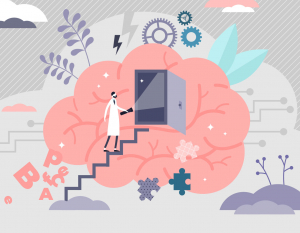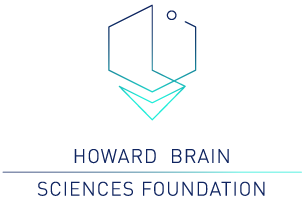In addition to ALS Awareness Month, May is also Mental Health Awareness Month. Mental Health Awareness Month was started in 1949 by Mental Health America to “provide practical tools that everyone can use to improve their mental health and increase resiliency regardless of the situations they are dealing with” (Mental Health America, 2020a).  There are currently 44 million American adults with mental illnesses, roughly 1 in 5 people will experience a mental illness during their lifetime (Mental Health America, 2020b). Despite the prevalence of mental illness, there is still a stigma against those with mental illnesses in our society. While there is a wide range of mental disorders and/or mental health difficulties one may have, some of the more common categories include Anxiety Disorders, Mood Disorders, Substance Use Disorders, and Psychotic Disorders.
There are currently 44 million American adults with mental illnesses, roughly 1 in 5 people will experience a mental illness during their lifetime (Mental Health America, 2020b). Despite the prevalence of mental illness, there is still a stigma against those with mental illnesses in our society. While there is a wide range of mental disorders and/or mental health difficulties one may have, some of the more common categories include Anxiety Disorders, Mood Disorders, Substance Use Disorders, and Psychotic Disorders.
Anxiety disorders are a group of disorders in which anxiety is persistent and interferes with a patient’s quality of life (National Institute of Mental Health, 2020a). Common Anxiety Disorders include Panic Disorder, Obsessive-Compulsive Disorder, Post-Traumatic Stress Disorder, Phobias, General Anxiety Disorder, and Social Anxiety Disorder (National Institute of Mental Health, 2020). Common stereotypes conflate Anxiety Disorders with being high stress or a “neat freak,” or seeking attention (Mental Health America, 2020c). Similarly, having an Anxiety Disorder is not a choice nor does it signify a personal flaw (Mental Health America, 2020c). Mental Health America states, 42.5 million American adults currently have an Anxiety Disorder, and most have other comorbid disorders (Mental Health America, 2020b).
Mood disorders include depression and bipolar disorder, amongst other disorders. Depression is the “leading cause of disability worldwide and is a major contributor to the overall global burden of disease” (World Health Organization, 2020a). Bipolar disorder is often mischaracterized as being prone to mood swings when the symptoms more usually manifest in cycles of depression, mania, or mixed states (National Institute of Mental Health, 2020b). Experts describe that depression “is different from usual mood fluctuations and short-lived emotional responses to challenges in everyday life” (World Health Organization, 2020a). Depression interrupts a person’s quality of life, and can be severe enough to lead to suicide (World Health Organization, 2020a).
Substance Use Disorders and Addictions are also a common problem. 8% of American adults and 4.6% of American youth had an addictive disorder in the past year (Mental Health America, 2020b). Common stereotypes of people with addictions portray them as prone to violence, poverty, and criminal activity (McGinty, Goldman, Pescosolido & Barry, 2015). Contrary to these stereotypes, there is no one type of person with an addictive disorder. Additionally, people with addictive disorders are more at risk of being victims of violence than perpetrators (McGinty et al., 2015). The American Psychiatric Association breaks possible substances down into the following categories: alcohol, caffeine, marijuana, hallucinogens, inhalants, opioids, sedatives, hypnotics and anxiolytics, stimulants, tobacco, or other (Mental Health America, 2020d).
People with schizophrenia and psychotic disorders face similar stereotypes to people with addictions in that they are often thought to be violent and an unstable group (McGinty et al., 2015). Again, people with psychotic disorders are more at risk of being victims of abuse and violence (McGinty et al., 2015). Additionally, schizophrenia does not consist of dissociative identities forming nor does it begin due to trauma or poor parenting (Mental Health America, 2020e). Symptoms of schizophrenia include delusions, hallucinations, disordered thinking and speech, social withdrawal, extreme apathy, and emotional flatness (Mental Health America, 2020e).
Other mental disorders are often diagnosed as eating disorders, personality disorders, learning disorders, and autism spectrum disorders. There is a wide range of mental health disorders, and one can struggle with mental health without meeting specific diagnostic criteria. For example, 4% of American adults have suicidal thoughts separate from what diagnoses they may or may not have (Mental Health America, 2020b). One also does not need to be in crisis to better their mental health. Examples of skills one can build in psychotherapy include problem-solving, resiliency, modifying negative behaviors, examining ways of thinking, healing from past pains, identifying goals, and building self-confidence (Mental Health America, 2020f).
If someone you know is facing a difficult time or has a mental disorder, there are additional resources and tips to support them. Educating oneself about their diagnosis, symptoms, and common treatments is a useful first step in developing empathy and a greater understanding to their illness (Mental Health America, 2020g). During this process, it is important to determine a reliable source of information that does not stigmatize or stereotype certain diagnoses (Mental Health America, 2020g). Listening to one’s friend or family member’s feelings without discounting them due to their disorder or illness is also critical (Mental Health America, 2020g). This also should be balanced with encouraging one’s friend or family member to seek professional help and empowering them to build their support network (Mental Health America, 2020). Mental Health America offers additional advice and links to tools on their website.
If you are looking for tools for yourself or a loved one, HBSF’s patient advocacy team can be reached at patientadvocacy@brainsciences.org for additional resources, while MHA offers a wide range of resources on their website.
References
McGinty, E. E., Goldman, H. H., Pescosolido, B., & Barry, C. L. (2015). Portraying mental illness and drug addiction as treatable health conditions: Effects of a randomized experiment on stigma and discrimination. Social Science & Medicine, 126, 73–85. https://doi.org/10.1016/j.socscimed.2014.12.010
Mental Health America. (2020a). Mental health month. Mental Health America. https://www.mhanational.org/mental-health-month
Mental Health America. (2020b). Quick facts and statistics about mental health. Mental Health America. https://www.mhanational.org/mentalhealthfacts
Mental Health America. (2020c). Life With Anxiety Fact Sheet. https://www.mhanational.org/sites/default/files/Life%20with%20Anxiety%20Fact%20Sheet.pdf
Mental Health America. (2020d). Addiction/substance use disorder. Mental Health America. https://www.mhanational.org/conditions/addictionsubstance-use-disorder
Mental Health America. (2020e). Schizophrenia. Mental Health America. https://www.mhanational.org/conditions/schizophrenia
Mental Health America. (2020f). Get professional help if you need it. Mental Health America. https://www.mhanational.org/get-professional-help-if-you-need-it
Mental Health America. (2020g). For family & friends. Mental Health America. https://www.mhanational.org/family-friends
National Institute of Mental Health. (2020a). Nimh » anxiety disorders. https://www.nimh.nih.gov/health/topics/anxiety-disorders/index.shtml
National Institute of Mental Health. (2020b). Nimh » bipolar disorder. https://www.nimh.nih.gov/health/topics/bipolar-disorder/index.shtml
World Health Organization. (2020a). Depression. https://www.who.int/news-room/fact-sheets/detail/depression
Your Support Helps HBSF to:
Continue to support student efforts by promoting their work and providing them with the tools and resources needed to carry out their research.
Educate the public about new advancements in the field and important developments surrounding AI, Machine Learning and technology in healthcare.
Conduct its own research studies without any restrictions allowing HBSF to have full autonomy and freedom to make those necessary, groundbreaking discoveries.
Foster multidisciplinary, collaborative research with the world’s top universities, mathematicians and scientists.
